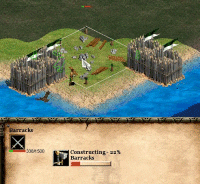
Early, swift, crippling attacks have long been a staple of RTS games. Known as rushes, these attacks are designed to permanently cripple or destroy the enemy by hitting him before he is ready for or even expecting an attack. Usually characterized by the use of a horde of one type of low-level unit, many people feel rushes are cheap or unfair, but the truth is that they are a perfectly valid strategy. Age of Kings was designed to make it much more difficult to rush than it was in Age of Empires, but it is still possible to win using a rush strategy.
There are many variations of the rush strategy, from the "Flush" first developed by gutter_rat, to the full-fledged, all-out, Men-at-Arms swarm. Despite the wide variety of options, however, there are a few important aspects common to all rushes. In any rush, forward building is a key element. It allows you to block your opponent in and keep him on the defensive from the very beginning of the game. It will also allow swift, brutal military attacks on the enemy's base much faster than if you were attacking from your own base. When forward building, always advance with at least 2 villagers, and be careful not to advance too close to the enemy's units or buildings. If your villagers or forward base are detected before you are ready to attack, your entire strategy could go down the drain. Build your buildings in a hidden location, but try to place them so that they give you control of that area of the map. A tricky strategy is to place the foundation of your building very near to the coast and begin construction. .
 |
Rushes can take place in the Feudal Age or the early Castle Age. Rushing, or even attacking at all in the Dark Age is suicide. A villager with the Loom upgrade has 40 HP, a 3 attack, 1/1 armor, and costs 50 food. A Militia, which costs 60 food and 20 gold, has the same HP, no armor, and only 1 more attack. Therefore a single Loominated villager can take on a single Militia, which is NOT an even trade. In the Feudal Age, however, things start to get a little more even. A few Archers with the Armor upgrade can take down many villagers, and Men-at-Arms are great for destroying buildings and killing workers. When rushing with Archers, don't bother attacking the enemy's buildings, instead hunt down and kill every last villager. Even if you are using a swarm of Men-at-Arms, avoid the enemy's TC and destroy all of his outlying buildings and villagers.
A Castle Age rush entails reaching Castle very early and harassing the enemy with a few early military units, usually Knights.
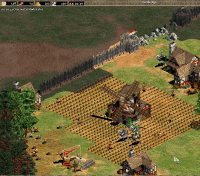 |
The Flush
The Flush is a strategy intended to be so swift and so aggressive that the enemy
doesn't even get a chance to defend himself. A typical player aiming for a
moderately fast Castle Age time will usually reach the Feudal Age around
14:00-14:00. When employed by a skilled player, the Flush can defeat this enemy
before he even reaches Feudal. Developed by gutter_rat (you can visit him at the
GamersX
Message Board), a good Flush will hit the enemy with a force capable of
knocking him out by 11:00 or even earlier. The Flush uses two important economic
tricks to be successful. The first is the act of "pulling" Boars to
the Town Center, and the second is the concept of "resource
specialization." Resource specialization is a strategy designed to acquire
the necessary resources for a task as swiftly and efficiently as possible. This
is accomplished by ignoring all other resources until they are absolutely
necessary. This concept is a very important part of the Flush, as it allows the
player to build up enough food to advance to the Feudal Age very swiftly but
once Feudal to have enough wood, gold and stone to do a strong Archer/Tower
assault.
Pulling boars is a strategy employed by experienced players to make hunting more efficient. It is performed by luring a Boar close to your Town Center with a single villager, and then ambushing it there with the rest (read: 5+) of your hunters. Usually your Scout will reveal 1 or 2 boars not too far away from your Town Center or Mill.
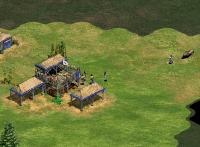 |
Here are the steps of a successful Flush:
1. As soon as the game starts, recruit 4 villagers, have your first 3 villagers
build a House, and begin scouting with your scout. Finding the 4 sheep near your
TC is very important.
2. When your first house finishes have 1 of the villagers build a second house, and send the other 2 to gather food from sheep. If you have not yet found your sheep at this point use these 2 villagers to scout around your base until you do so.
3. Set the queue point of your Town Center on a sheep and have your all your villagers gather sheep until your 8th villager (population of 9 counting the scout), who should build a Mill at your berries, and then gather berries. 4. Put the next 3 villagers on berries. Don't forget to use queue points.
5. Keep scouting with your scout. Your primary goals should be to locate 1 or 2 boars within a short distance from your TC and/or Mill, and finding extra sheep. Once you have done both of these, send the scout out to locate more sheep in the middle of the map and to locate the enemy's base. 6. Send your 12th villager (pop 13) out to the closest boar. 7. If you have not yet finished gathering food from your sheep, build a house with the 12th villager that just came out of your TC. If you have finished your sheep, build a house with your former shepherds. 8. Attack the boar once with your 12th villager and then run back to your TC/Mill, where you should have the rest of your shepherds waiting to kill it and harvest meat.
9. Send villager 13 to berries.
10. Set the TC's queue point to the closest tree and have your 14th, 15th and 16th villagers chop wood. Your population should now be at 18. You should have 1 scout, 3 villagers chopping wood, 6 foraging, and 8 hunting gathering food from a boar. Remember this is just a typical rush, don't feel that you must perform your strategy this exact way every time, sometimes variations can increase your speed and efficiency, depending on the map. 11. At your 17th villager (18 pop) you should have just enough wood to build another house. This is also a good time to move all of your villagers off of berries and hunt any other boars nearby using the same method described above. If you do so, put the next 2 villagers on this boar. If you haven't found any other boars, leave these villagers on berries and put the next 3 on berries too.
¡@
 |
13. Using queue points (you ARE using queue points, aren't you?) assign the next 4 villagers to wood. This should bring you to a 23 population.
14. As soon as you have enough wood, build a lumber camp at the closest forest and begin chopping wood there.
15. As soon as you get enough food to advance to Feudal, move all of your food gatherers (this should be 1 large group of hunters) to wood. Don't be afraid to tell your villagers to drop off meat before they are holding their full capacity, if it will immediately put you over 500, go for it. Also don't worry about wasting some boar meat, you don't need it anymore.
16. Before you advance, research the Loom at your Town Center. Once this is complete, advance to the Feudal Age.
17. Hopefully now you will be advancing to Feudal by 8:00-8:30 with a 23 population. Right when you begin advancing, take 3 or 4 villagers off wood and tell them to walk to the enemy's base. Don't tell them to move all the way in, but wait outside. 18. As soon as you have 100 wood, build a Mining Camp by your gold mine and move 5 or 6 villagers to gold.
19. When your 3-4 forward builders reach the enemy's base, you should have enough wood for a Barracks. You should build your barracks near the enemy's gold pile, but not too close that he will see it. Use your scout to figure out the perfect position.
20. You should reach Feudal with enough wood to build an Archery Range near your Barracks. Also, as soon as you have enough wood build another Mining Camp at your stone pile, and tell 2 villagers to mine stone.
21. When your forward Archery Range is up begin recruiting Archers.
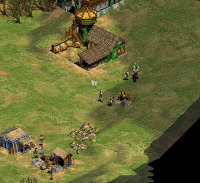 |
22. Use your forward builders to build a Tower right next to the enemy's gold as soon as you have a couple of Archers. Make sure the entire mine will be within the Tower's range. This Tower is very important as it will prevent the enemy from mining gold, without which he cannot advance to Castle or recruit his own Archers.
23. When your tower is finished build another Archery Range. Don't stop recruiting Archers from your first. Once this is finished, move in with your Archers and attack the enemy's wood gatherers. Also use your scout to locate any more gold mines and the enemy's stone mine. You should guard each of these locations with an Archer or 2.
¡@
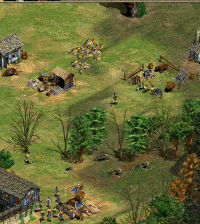 |
25. Carry on the destruction from here. You will soon build up quite a large amount of wood. Take some villagers off of wood and tell them to finish off your berries, and tell others to build farms. You should build a Blacksmith and research Fletching, which will increase your Archers' and Towers' ranges and damage. I'll leave the rest up to you. Your goals should now be to keep the enemy from acquiring more gold by continuous scouting and pressure, and to begin evening out your economy.
I've written this strategy based on a typical civilization's start. I would
recommend using the Britons, Celts, Mongols, or Teutons, though the civ that is
most suitable for this strategy is the Chinese. Their extra villagers at the
beginning give you a slight speed increase, and their early Loom helps a lot.